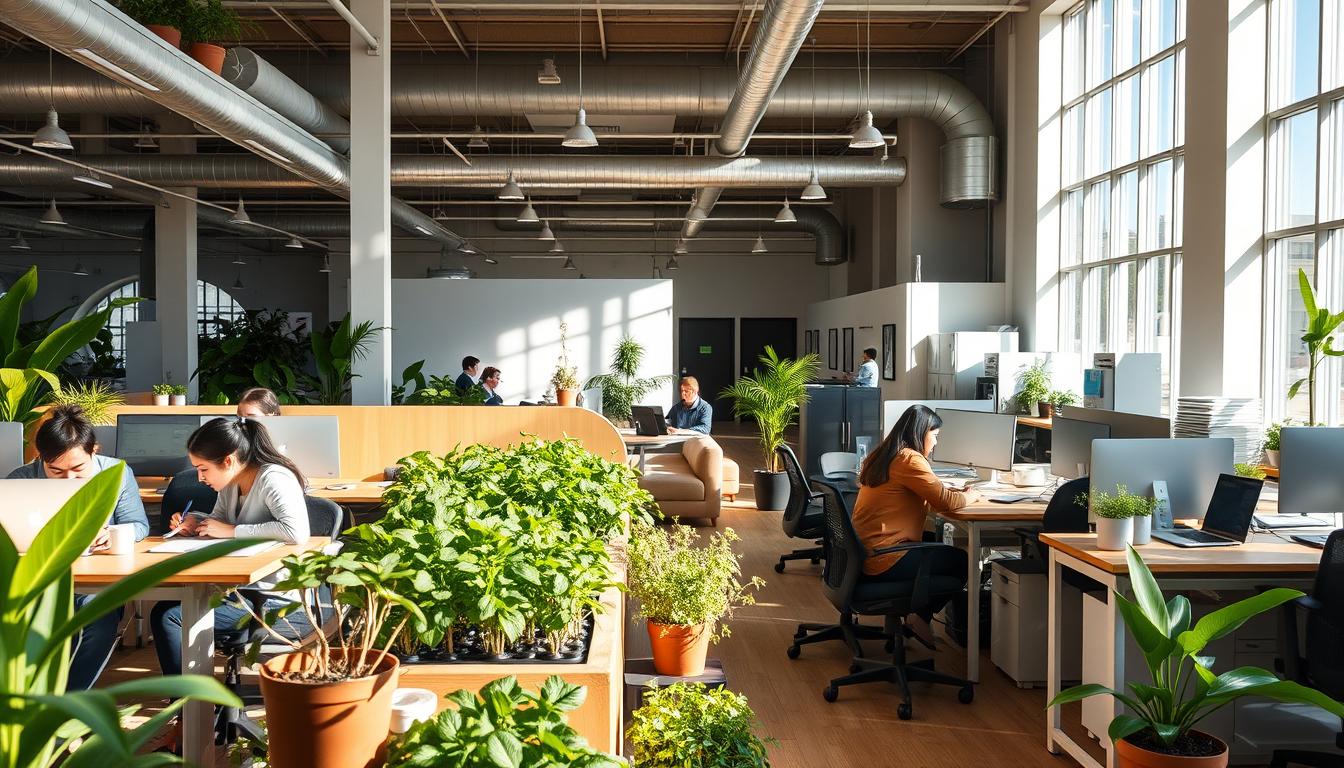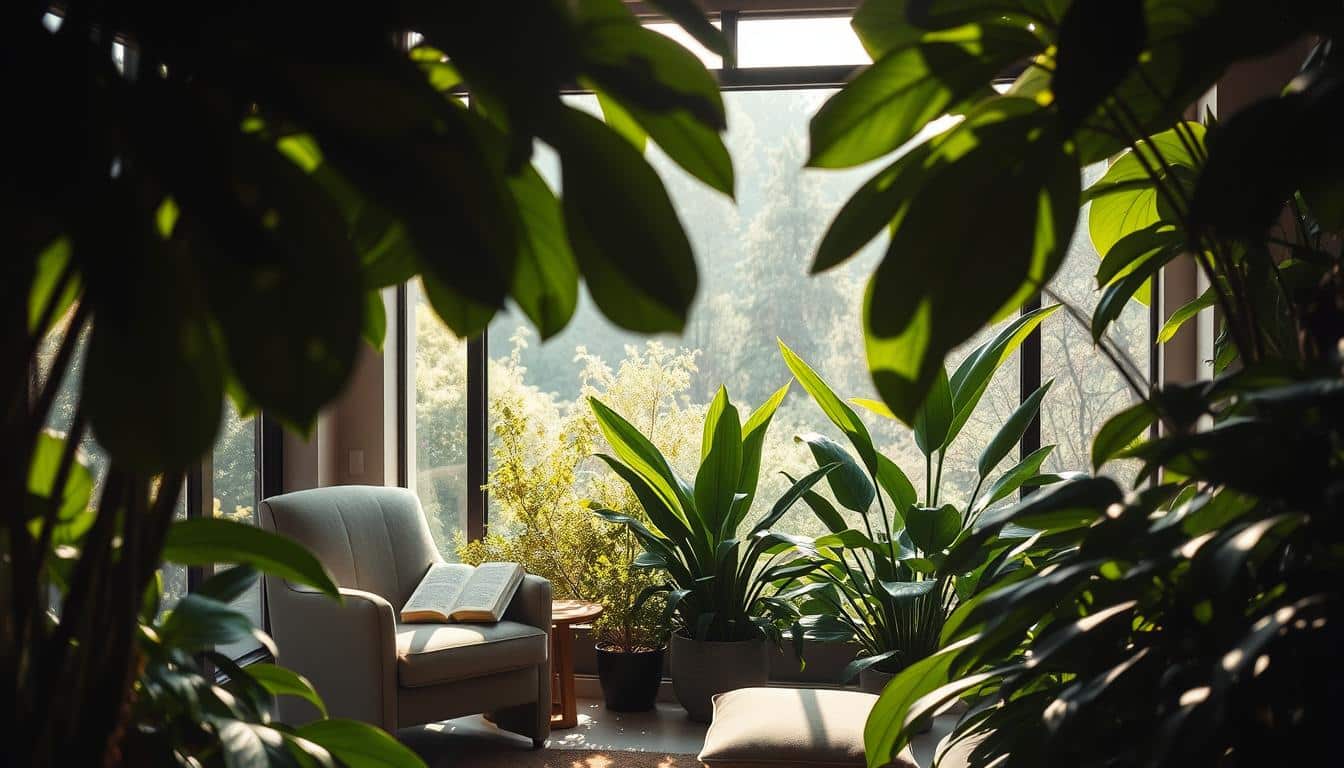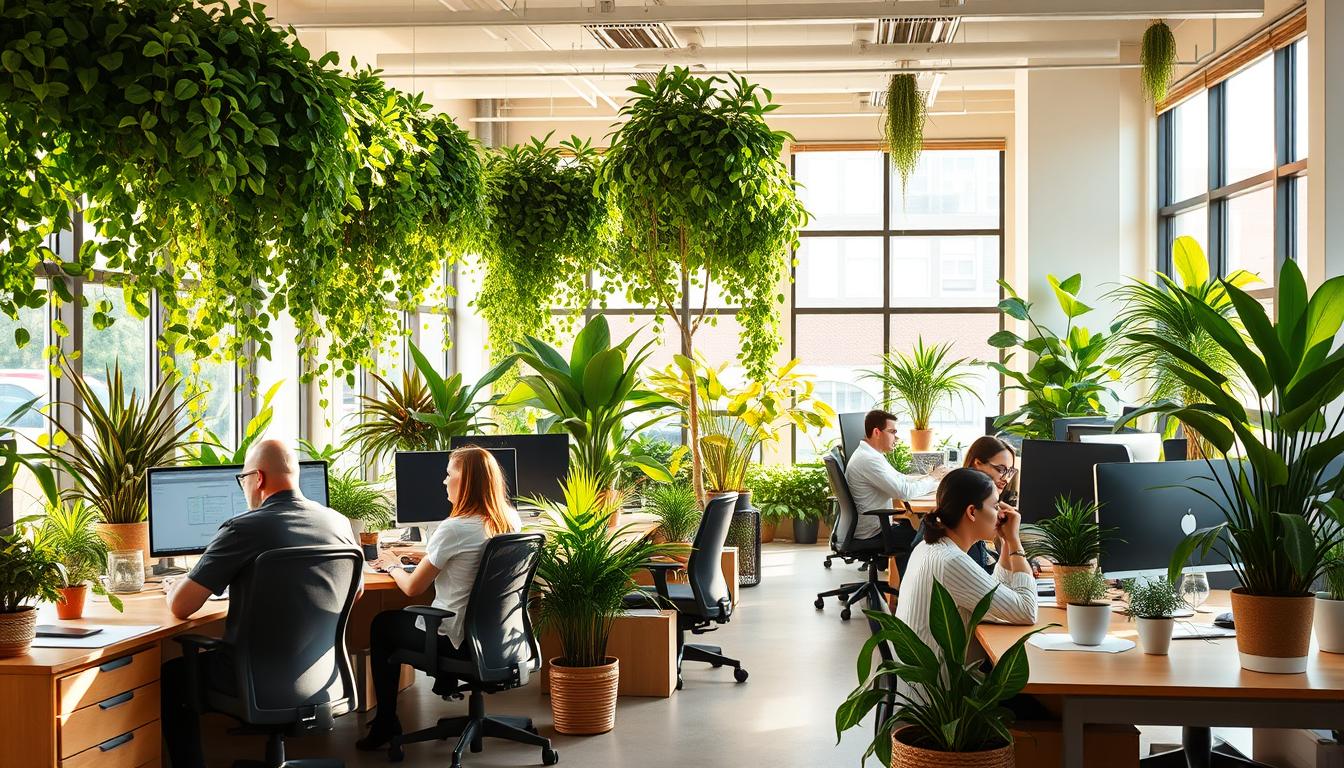In our fast-paced work world, making a green workspace is important. It helps people feel good and takes care of our planet. Using plants to cool offices not only looks nice but also helps the environment.
This guide shows how plants can fight climate change and make indoors better. That leads to more work getting done and happier employees. We’ll look at helpful ways and the right plants to make offices more eco-friendly.
Understanding the Importance of Eco-Friendly Solutions
Today, eco-friendly solutions are becoming vital in the business world. Companies are aware of how their actions affect our environment. They are moving towards sustainable practices to lessen their carbon footprints. Activities like using plant-based cooling systems help fight climate change. They also improve a company’s image.
Using green practices helps businesses meet tough regulations. These laws are getting stricter to protect our planet. Going green can also save money over time due to improved energy use. Workplaces become healthier, which can boost worker happiness and productivity. This shows that caring for the environment and making a profit can go hand in hand.

Benefits of Natural Plant Cooling in Small Offices
For small offices, natural plant cooling is very beneficial. It’s not only budget-friendly but also energy efficient. By adopting this eco-friendly method, work areas become healthier, and you save a lot on energy bills.
Cost-Effective Cooling Solutions
Plants can cool an office without relying too much on air conditioning. They release moisture into the air, which cools the space naturally. This lowers energy use and cuts down your utility bills.
Even though setting up a plant system might cost a bit at first, you’ll save more money in the long run. That’s because it reduces how much energy you use.
Enhancing Indoor Air Quality
Adding plants to your office space does wonders for the air quality. Plants act like natural air filters, removing harmful toxins such as carbon dioxide. This can help prevent issues like sick-building syndrome.
When the air is cleaner, everyone works better and feels healthier. Having plants around also makes for a peaceful environment. It helps people think clearer and feel less stressed. Being close to nature makes employees happier and more engaged at work.
Types of Plants That Help with Cooling
Picking the right plants can cool down your office space. The top choices do more than look good. They help keep the area cool naturally. Peace lilies, spider plants, and snake plants are great options. They clean the air, are easy to care for, and do well in different light.
Choosing the Right Indoor Plants
Knowing the needs and perks of each plant is key. The best ones for cooling can lower temperatures around them. Peace lilies, spider plants, and snake plants are top picks.
- Peace Lily: Cleans the air well and loves low light.
- Spider Plant: Easy to care for and helps keep things cool.
- Snake Plant: Tough and good at cleaning the air, perfect for cooling.
Top Plants for Natural Air Conditioning
Some plants are known for their cooling effects. They take in heat and moisture, making inside air nicer. Pothos, Ficus elastica, and Dracaena are among the best choices for this.
- Pothos: Climbs and cleans the air.
- Ficus elastica: Makes spaces beautiful with its green leaves.
- Dracaena: Cools down the area and adds a pop of color.
Natural Plant Cooling in Small Offices
Using plants to cool your office, like green walls and vertical gardens, makes small offices more comfortable and beautiful. These plants are more than just nice to look at. They help clean the air, lower energy bills, and are eye-catching.
Implementing Green Walls
Green walls are great for businesses in small spaces wanting to cool down their area. They arrange plants in a way that brings lots of benefits. Some key pluses are:
- Enhanced insulation and cooling effects
- Improved climate control capabilities
- Bio-filtration that naturally purifies air
- Reduction of acoustic distractions in workspaces
Creating Indoor Vertical Gardens
Vertical gardens let you brighten up your space without using too much floor. Planning well ensures they look good and thrive. Keep these points in mind:
- Selecting diverse plant species that thrive in varying light levels
- Employing thoughtful plant arrangement to achieve a harmonious aesthetic
- Developing a maintenance plan that supports longevity and sustainability
Factors to Consider for Plant Placement
Putting plants in an office makes it look and work better. Knowing how to do this well is important. It helps plants grow and makes the office nicer.
We must think about plants’ light needs and where to put them. This helps plants grow well and makes the office look good.
Light Requirements
Different plants need different amounts of light to stay healthy. Knowing what they need helps us decide where to put them. Some plants do well in low light, while others need a lot of light.
- Low-light plants such as snake plants and pothos are excellent for dim areas.
- Moderate-light plants like spider plants and peace lilies benefit from filtered sunlight.
- High-light varieties such as succulents and cacti prefer direct sunlight.
It’s important to know what plants need. This helps them grow and makes the office cooler and greener.
Space and Layout Considerations
Adding plants to an office is about more than just looks. We need to think about where furniture is and where people walk.
- Evaluate existing furniture to prevent obstruction of light and airflow.
- Consider pedestrian traffic to avoid accidental damage to plants.
- Plan for accessibility to ensure regular maintenance, which is vital for plant care.
Managing space well helps plants grow and cools the office. It makes the office more pleasant for everyone.
Maintenance Tips for Office Plants
Keeping plants healthy in offices needs regular care. A steady watering plan helps avoid harm from too much or too little water. Cutting off dead leaves makes plants look better and promotes growth while stopping disease. It’s key to check if the soil is right and moist enough for each plant.
Setting up a plant care routine is easy. Having someone in charge of plant care brings responsibility. This ensures plants get what they need. For offices with many plants, expert care services offer more knowledge and save time.
These steps help create a lively and green office. Healthy plants make working spaces look good and the air cleaner. Taking care of office plants betters the look and feel of your space.
Addressing Common Plant Challenges
Having plants in your office comes with challenges like pests, diseases, and varying light and humidity. It’s key to recognize these issues to keep your plants healthy. Using natural insect repellents helps fight off pests without using bad chemicals.
Dealing with pests is just one part. You also need to check for environmental issues that harm plant health. Checking your plants regularly helps spot problems like dryness or not enough light. This lets you fix these problems quickly. By making your plants strong, they not only survive but also help cool your office naturally.
Understanding and dealing with common plant problems helps make your indoor space healthier. This makes the space better for work and helps everyone feel good. It shows how a green office can be great for everyone.



